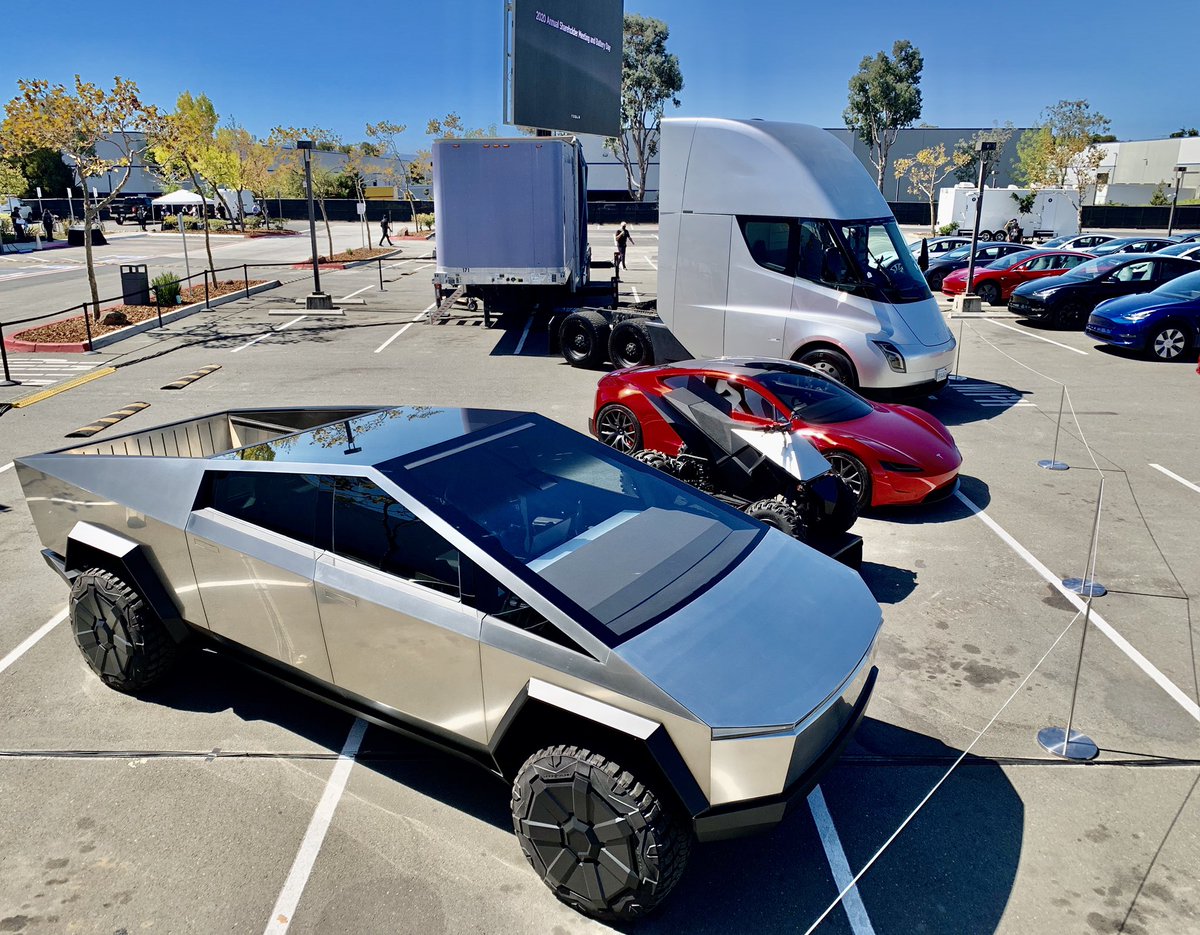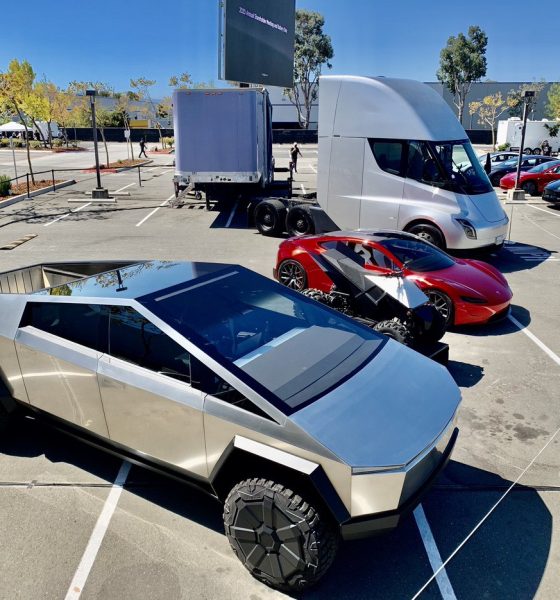The Tesla Cybertruck. The Tesla Roadster. The Tesla Semi.
The three products above saw new expected production dates from Tesla CEO Elon Musk on Thursday at its “Cyber Rodeo” at Gigafactory Texas. Despite Tesla accomplishing so many incredible things over the past fourteen years, from basically financial ruin to the most valuable automaker in the world, 2023 is a chance for the company to truly break away from its competitors once and for all. It just has to come through on its promises.
It is no secret Tesla has come up short with some of its delivery timelines. The Cybertruck was slotted for production in late 2020. The Roadster’s revamped version has been pushed back several times. The Semi is still a priority, but so are saving battery cells for the mass-market vehicles Tesla produces. Full Self-Driving was slotted to be completed for the first time in 2018. 30,000 Robotaxis were expected to hit the streets by the end of 2021.
Then the pandemic hit in 2020, and the entire automotive industry felt the effects. While resilient in its efforts to avoid chip shortages, supply bottlenecks, and an extending backlog, Tesla took matters into its own hands. It said it developed 19 versions of microcontrollers thanks to the efforts of its in-house engineers, it ramped production of its 4680 battery cells, which it implemented in the first Made-in-Austin Model Ys, and it opened two new factories in the first four months of 2022, effectively doubling its production output as a company.
But more than anything, 2023 is a chance for Tesla to truly break away from its competitors in terms of its product line. While many companies are focused on passenger or commercial electric vehicles exclusively, Tesla has an opportunity to expand its product line to fit nearly every sector of transportation.
The Cybertruck will be the fourth all-electric pickup on the market, following the Rivian R1T, the GMC Hummer EV, and the Ford F-150 Lightning.
The Roadster will be the first of its kind: an estimated 600+ miles of range combined with an already proven and lightning-fast powertrain, and it might even hover.
Meanwhile, the Semi will expand the commercial electric vehicle market as Volvo’s VNR electric semi, and Nikola’s plans for commercial EVs continue to work through a tumultuous year.
Tesla’s Elon Musk predicts that 2023 will see massive “wave of new products”
The Cybertruck is absolutely the priority for Tesla: the truck has over 1 million pre-orders, and the list of reservations continues to grow with every new sighting. If Tesla can dial in production of the Cybertruck in 2023, it will not only deny so many naysayers of their skepticism, but it will also prove the company has effectively outgrown its cell supply shortages and parts bottlenecks.
The Roadster, while more of a novelty item, will bring the automaker’s revamped and revolutionary vehicle back from the dead. After so many customers and Referral Program winners may have given up on ever seeing the next-gen Roadster, Tesla bringing that project back from the dead would mean so much to the early adopters and the patient and loyal fans who have ached for the futuristic and sleek rebirth of the original Tesla vehicle.
The Semi would only prove Tesla dominance even further. It would be a large-scale commercial vehicle that supplements Tesla’s already robust and expansive product line. Covering the luxury, mass market, pickup truck, and commercial sectors would be monumental for a company that has already changed the overall architecture of the global automotive industry.
“My view is that many on the Street and the auto industry do not appreciate just how important and revolutionary the Austin factory is for Tesla,” Wedbush analyst Dan Ives said. “It changes the game for Tesla from a supply perspective along with Berlin-further flexes production muscles when other autos struggling.”
I’d love to hear from you! If you have any comments, concerns, or questions, please email me at joey@teslarati.com. You can also reach me on Twitter @KlenderJoey, or if you have news tips, you can email us at tips@teslarati.com.

Elon Musk
Starlink passes 9 million active customers just weeks after hitting 8 million
The milestone highlights the accelerating growth of Starlink, which has now been adding over 20,000 new users per day.

SpaceX’s Starlink satellite internet service has continued its rapid global expansion, surpassing 9 million active customers just weeks after crossing the 8 million mark.
The milestone highlights the accelerating growth of Starlink, which has now been adding over 20,000 new users per day.
9 million customers
In a post on X, SpaceX stated that Starlink now serves over 9 million active users across 155 countries, territories, and markets. The company reached 8 million customers in early November, meaning it added roughly 1 million subscribers in under seven weeks, or about 21,275 new users on average per day.
“Starlink is connecting more than 9M active customers with high-speed internet across 155 countries, territories, and many other markets,” Starlink wrote in a post on its official X account. SpaceX President Gwynne Shotwell also celebrated the milestone on X. “A huge thank you to all of our customers and congrats to the Starlink team for such an incredible product,” she wrote.
That growth rate reflects both rising demand for broadband in underserved regions and Starlink’s expanding satellite constellation, which now includes more than 9,000 low-Earth-orbit satellites designed to deliver high-speed, low-latency internet worldwide.
Starlink’s momentum
Starlink’s momentum has been building up. SpaceX reported 4.6 million Starlink customers in December 2024, followed by 7 million by August 2025, and 8 million customers in November. Independent data also suggests Starlink usage is rising sharply, with Cloudflare reporting that global web traffic from Starlink users more than doubled in 2025, as noted in an Insider report.
Starlink’s momentum is increasingly tied to SpaceX’s broader financial outlook. Elon Musk has said the satellite network is “by far” the company’s largest revenue driver, and reports suggest SpaceX may be positioning itself for an initial public offering as soon as next year, with valuations estimated as high as $1.5 trillion. Musk has also suggested in the past that Starlink could have its own IPO in the future.
News
NVIDIA Director of Robotics: Tesla FSD v14 is the first AI to pass the “Physical Turing Test”
After testing FSD v14, Fan stated that his experience with FSD felt magical at first, but it soon started to feel like a routine.

NVIDIA Director of Robotics Jim Fan has praised Tesla’s Full Self-Driving (Supervised) v14 as the first AI to pass what he described as a “Physical Turing Test.”
After testing FSD v14, Fan stated that his experience with FSD felt magical at first, but it soon started to feel like a routine. And just like smartphones today, removing it now would “actively hurt.”
Jim Fan’s hands-on FSD v14 impressions
Fan, a leading researcher in embodied AI who is currently solving Physical AI at NVIDIA and spearheading the company’s Project GR00T initiative, noted that he actually was late to the Tesla game. He was, however, one of the first to try out FSD v14.
“I was very late to own a Tesla but among the earliest to try out FSD v14. It’s perhaps the first time I experience an AI that passes the Physical Turing Test: after a long day at work, you press a button, lay back, and couldn’t tell if a neural net or a human drove you home,” Fan wrote in a post on X.
Fan added: “Despite knowing exactly how robot learning works, I still find it magical watching the steering wheel turn by itself. First it feels surreal, next it becomes routine. Then, like the smartphone, taking it away actively hurts. This is how humanity gets rewired and glued to god-like technologies.”
The Physical Turing Test
The original Turing Test was conceived by Alan Turing in 1950, and it was aimed at determining if a machine could exhibit behavior that is equivalent to or indistinguishable from a human. By focusing on text-based conversations, the original Turing Test set a high bar for natural language processing and machine learning.
This test has been passed by today’s large language models. However, the capability to converse in a humanlike manner is a completely different challenge from performing real-world problem-solving or physical interactions. Thus, Fan introduced the Physical Turing Test, which challenges AI systems to demonstrate intelligence through physical actions.
Based on Fan’s comments, Tesla has demonstrated these intelligent physical actions with FSD v14. Elon Musk agreed with the NVIDIA executive, stating in a post on X that with FSD v14, “you can sense the sentience maturing.” Musk also praised Tesla AI, calling it the best “real-world AI” today.
News
Tesla AI team burns the Christmas midnight oil by releasing FSD v14.2.2.1
The update was released just a day after FSD v14.2.2 started rolling out to customers.

Tesla is burning the midnight oil this Christmas, with the Tesla AI team quietly rolling out Full Self-Driving (Supervised) v14.2.2.1 just a day after FSD v14.2.2 started rolling out to customers.
Tesla owner shares insights on FSD v14.2.2.1
Longtime Tesla owner and FSD tester @BLKMDL3 shared some insights following several drives with FSD v14.2.2.1 in rainy Los Angeles conditions with standing water and faded lane lines. He reported zero steering hesitation or stutter, confident lane changes, and maneuvers executed with precision that evoked the performance of Tesla’s driverless Robotaxis in Austin.
Parking performance impressed, with most spots nailed perfectly, including tight, sharp turns, in single attempts without shaky steering. One minor offset happened only due to another vehicle that was parked over the line, which FSD accommodated by a few extra inches. In rain that typically erases road markings, FSD visualized lanes and turn lines better than humans, positioning itself flawlessly when entering new streets as well.
“Took it up a dark, wet, and twisty canyon road up and down the hill tonight and it went very well as to be expected. Stayed centered in the lane, kept speed well and gives a confidence inspiring steering feel where it handles these curvy roads better than the majority of human drivers,” the Tesla owner wrote in a post on X.
Tesla’s FSD v14.2.2 update
Just a day before FSD v14.2.2.1’s release, Tesla rolled out FSD v14.2.2, which was focused on smoother real-world performance, better obstacle awareness, and precise end-of-trip routing. According to the update’s release notes, FSD v14.2.2 upgrades the vision encoder neural network with higher resolution features, enhancing detection of emergency vehicles, road obstacles, and human gestures.
New Arrival Options also allowed users to select preferred drop-off styles, such as Parking Lot, Street, Driveway, Parking Garage, or Curbside, with the navigation pin automatically adjusting to the ideal spot. Other refinements include pulling over for emergency vehicles, real-time vision-based detours for blocked roads, improved gate and debris handling, and Speed Profiles for customized driving styles.










